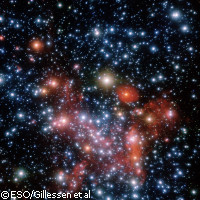Sixteen-year-long study tracks 28 stars orbiting the Milky Way's massive black hole
After 16 years of dedicated work, astronomers in Germany, France, the US, Israel and Chile have calculated the orbits of 28 stars at the centre of our galaxy, revealing new information about the massive black hole called Sagittarius A* at the heart of the Milky Way. Their findings, which also provide insight into the formation of stars, are published in the online journal arXiv. 'The centre of the galaxy is a unique laboratory where we can study the fundamental processes of strong gravity, stellar dynamics and star formation that are of great relevance to all other galactic nuclei, with a level of detail that will never be possible beyond our galaxy,' explained Reinhard Genzel of the Max Planck Institute for Extraterrestrial Physics in Germany. Because the central region of the Milky Way is obscured by interstellar dust, the scientists used infrared wavelengths to watch the central stars move around Sagittarius A*. Their observation of the stars' orbits allowed them to infer important properties of the black hole, such as its mass, and to recalculate the distance of the Galactic Centre, a measurement fundamental to existing models of our galaxy. The study began in 1992, when the scientists began gathering high-resolution images of the Galactic Centre region using the SHARP camera, which is attached to the European Southern Observatory's (ESO) 3.5-metre New Technology Telescope in Chile. Starting in 2002, more advanced imaging data was collected using the Naos-Conica (NACO) system, which is mounted on ESO's 8.2-metre Very Large Telescope (VLT), and starting in July 2004 spectroscopic observations were made possible by the SINFONI field spectrometer, also mounted on the VLT. The study has dramatically improved the accuracy by which the positions of the stars may be measured. The precision of their calculation is within 300 microarcseconds, the equivalent to seeing a one-euro coin from a distance of roughly 10,000 km. The observations allowed the scientists to update the estimate of the distance to the Galactic Centre, an important calculation. One of the main achievements of the study was an observation of a complete orbit of a star named S2, one of the brightest observed, which accomplished a full revolution of the Milky Way's centre in about 15 years. (For comparison, the Sun's galactic rotation period is around 200 million years.) This observation of a complete orbit made the high accuracy of the calculations possible. Interestingly, though, the researchers noted that at a certain point the brightness of S2 and its velocity changed; an explanation of this variation remains a matter of fascinating debate. The study obtained orbits for 20 early-type stars. This major increase in the number of known orbits allows scientists to look for common properties amongst them, thereby characterising this central population of stars. 'The stars in the innermost region are in random orbits, like a swarm of bees,' said lead author Stefan Gillessen of the Max Planck Institute for Extraterrestrial Physics. The scientists determined the orbits of six late-type stars in this region for the first time, and also confirmed earlier speculation that six early-type stars orbit the black hole clockwise, in a disc. Much can be learned about the origin of the central stars by determining the properties of their orbits. The scenarios for the formation of these stars remain a focus of ongoing study, as they are too young to have migrated there, but probably did not form in their current orbits, where the tidal forces of the black hole hold sway. Based on their observations, the astronomers speculated that in addition to the massive black hole, a substantial amount of mass in the form of a cluster of 'dark stellar remnants' might reside around the black hole. 'Undoubtedly the most spectacular aspect of our long-term study is that it has delivered what is now considered to be the best empirical evidence that super-massive black holes do really exist,' said Mr Genzel. 'The stellar orbits in the Galactic Centre show that the central mass concentration of four million solar masses must be a black hole, beyond any reasonable doubt.' 'The next major advance will be to combine the light from the four 8.2-metre VLT unit telescopes - a technique known as interferometry,' said Frank Eisenhauer, principal investigator of the next generation instrument GRAVITY. 'This will improve the accuracy of the observations by a factor 10 to 100 over what is currently possible. This combination has the potential to directly test Einstein's general [theory of] relativity in the presently unexplored region close to a black hole.'
Countries
Chile, Germany, France, Israel, United States



